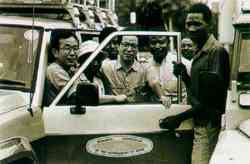Both Eyes Open
Botheyesopen
Manomi Suzuki explains why the Japanese people
must watch what the world’s largest donor gets up to.
Five years ago Japan overtook the US to become the world’s largest aid donor. It has a self-imposed target of $75 billion dollars to be given in aid between 1993 and 1997. But economic recession, shaking the structural basis of Japan’s post-war economy, means that the target will probably be missed.
Japan’s aid is based on youseishugi, which means ‘responding to requests from recipients’. But in many cases these ‘requests’ come from Japanese companies and institutions in close collaboration with powerful bureaucrats, politicians and business people in the aid-receiving countries.
Last year the Fair Trade Commission ruled that 37 companies (including Mitsubishi and Mitsui) had to stop rigging the bids for contracts with the Japan International Co-operation Agency (JICA). The Research and Study Group went on to point out: ‘Even with partially tied aid, where companies from Japan and from other recipient countries are allowed to participate, the project specifications usually require “Japanese standards”, meaning that even if local companies win bids they have to purchase all the materials from Japan.’
Aid is also used to provide Japanese companies with more business. For example, the yen loan extended to Indonesia for the development of oil and liquid natural gas, and the one given to China for the construction and modernization of coal-related transport systems, were both designed to ensure the steady delivery of energy resources to Japan, rather than to benefit the aid-receiving country.
Advert
In June 1992 Japan adopted an Official Assistance Charter. Its principles implied a shift in aid priorities from economics to giving Japan an international political platform, on which democracy and human rights would play as large a part as the introduction of a market economy.
Since the adoption of the Charter, serious violations of human rights have been observed in dozens of places where Japan gives aid, including East Timor, Burma, Thailand and China. But the Charter has not always made much difference. When the Indonesians massacred East Timorese in Dili in 1991, Japan did no more than ask the Indonesian Government for an official inquiry. Japan is the largest aid donor to Indonesia and its top trading partner.
On the other hand, in August 1995 the Japanese Government decided to freeze grant aid to China in protest at nuclear testing. In the event, maintaining Sino-Japanese relations overwhelmed this argument. There has been fierce debate about aid to China ever since it began in 1979: to date, Japan has provided 40 per cent of the aid received by China and played an active role in assisting economic reform. The Western view of China has been critical of its repression of the human-rights movement, while Japan argues that modernization encourages stability, which in the long run contributes to the stability of Asia as a whole.
Japan is likely to continue with a reduced aid programme, keeping one eye on its own economic interests and the other on its standing in the world. Japanese citizens will need to be watchful over what happens next.
Manomi Suzuki is a freelance writer based in Tokyo.
![]()
![]()
![]()
![]()
Issue 285 Contents ![]() NI Home Page
NI Home Page
©Copyright: New Internationalist 1996
This article is from
the November 1996 issue
of New Internationalist.
- Discover unique global perspectives
- Support cutting-edge independent media
- Magazine delivered to your door or inbox
- Digital archive of over 500 issues
- Fund in-depth, high quality journalism













































